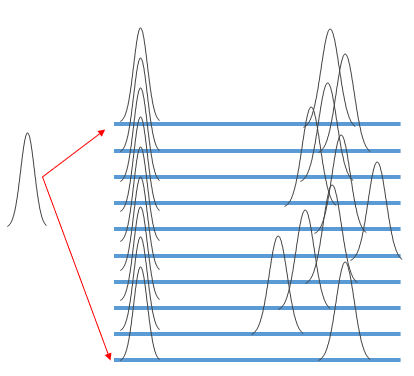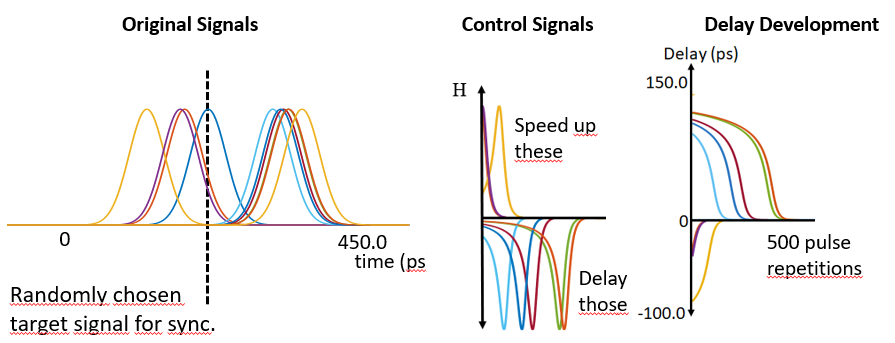
ADSYNX - Adaptive control method for signal synchronization
The ADSYNX technology provides a fast and adaptive method for the synchronization of different signals (skew compensation) for any electrical or optical system up to the GHz regime.
Challenge
The transmission of electrical or optical signal groups often leads to different travel times and asynchronous arrival at a detector. This can occur due to multiple reasons including, but not restricted to, differences in production (material properties), thermally induced differences, different transmission delays in the system, etc., even if the signal source is identical. In addition, widening of pulse groups or other distortions can happen. Processing of such signals requires prior temporal synchronization for which ADSYNX offers a powerful solution. Methods based on conventional control mechanisms have various disadvantages based on the type of synchronization. In most cases, recurring calibration is necessary, while at the same time these methods are limited in temporal resolution or concerning the type of signals which can be synchronized.
Our Solution
The present invention suggests a smart method for the synchronization of any number of electrical or optical signals in a fast, iterative and adaptive way. Due to this, the adaptive synchronization system –ADSYNX– does not require any calibration procedure. ADSYNX continuously analyzes the different signal arrival times at the detector and creates a control signal that can be used with any application to shift signal groups accordingly until synchronization is achieved.
 Fig. 1 Synchronous optical input signals get de-synchronzied along some cable distance due to temperature and/or fabrication differences. Optical signals obtain realistically about +-200 ps pulse-center dispersion for 10 km fiber length. (Image Source: Prof. Dr. Florentin Wörgötter, Georg-August-Universität Göttingen)
Fig. 1 Synchronous optical input signals get de-synchronzied along some cable distance due to temperature and/or fabrication differences. Optical signals obtain realistically about +-200 ps pulse-center dispersion for 10 km fiber length. (Image Source: Prof. Dr. Florentin Wörgötter, Georg-August-Universität Göttingen)
 Fig. 2 Skew in 10 fibers is compensated. The panels show the original 10 signals at the receiver at start of the experiment (left), the control signals (middle) and the resulting delay development (right) where all delays drop to zero at about 500 pulse-group repetitions. At a carrier frequency of 10 GHz this happens after 50ns. Control is performed by adjusting the time of pulse insertion by the laser for the different fibers. (Image Source: Prof. Dr. Florentin Wörgötter, Georg-August-Universität Göttingen)
Fig. 2 Skew in 10 fibers is compensated. The panels show the original 10 signals at the receiver at start of the experiment (left), the control signals (middle) and the resulting delay development (right) where all delays drop to zero at about 500 pulse-group repetitions. At a carrier frequency of 10 GHz this happens after 50ns. Control is performed by adjusting the time of pulse insertion by the laser for the different fibers. (Image Source: Prof. Dr. Florentin Wörgötter, Georg-August-Universität Göttingen)
Advantages
- Fast and iterative method
- Adaptive procedure, calibration not needed, flexible response to fluctuating initial conditions
- Usable for any electrical or optical signals
- Modular system: block wise expansion is possible, any possible number of signals can be synchronized
- Implementable in analogue as well as digital hardware
Applications
The present invention is relevant for the fast temporal synchronization of electrical or optical signals. It provides substantial advantage for any application that benefits from synchronous signal input allowing for precise postprocessing. The degree of the initial signal skew is not relevant and synchronization does not depend on it.
- Telecommunication
- GPS
- Clock-synchronization in wireless transmission
- augmented reality
- essentially all systems where synchronous signal transmission is relevant
- Fiber optic-based transmission systems as well as wire-based or wireless transmission up to the GHz regime
Example application domains:
Example technologies:
Development Status
Algorithm and optoelectronic setup are complete and ready to use. Small adaptations can be done depending on application
Patent Status
German patent application filed: DE102022132996.8
Patent holder: Georg-August-University of Göttingen Public Law Foundation.
Weiterführende Informationen (in h2)
Absatz 8
Kontakt
Dr. Maria Kamper
Patent Manager (Physics, Technology and Software)
E-Mail: Diese E-Mail-Adresse ist vor Spambots geschützt! Zur Anzeige muss JavaScript eingeschaltet sein!
Tel.: +49 551 30724 154
Referenz: MM-2396-SUG
(Image Source: Prof. Dr. Florentin Wörgötter, Georg-August-Universität Göttingen)
Tags: Mess- und Analysetechnik
